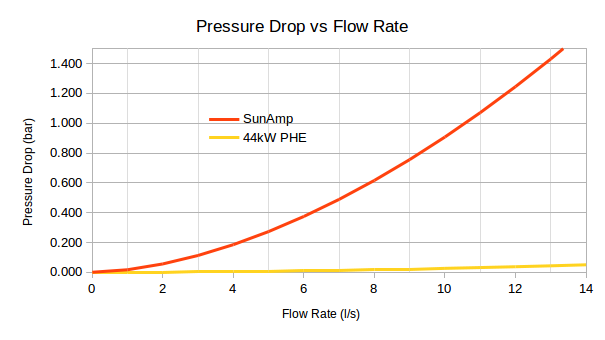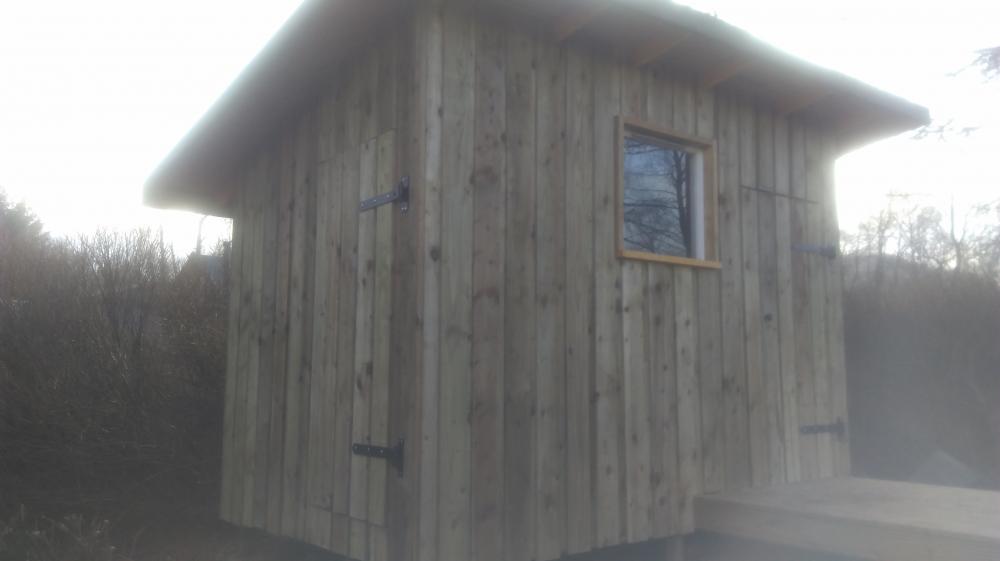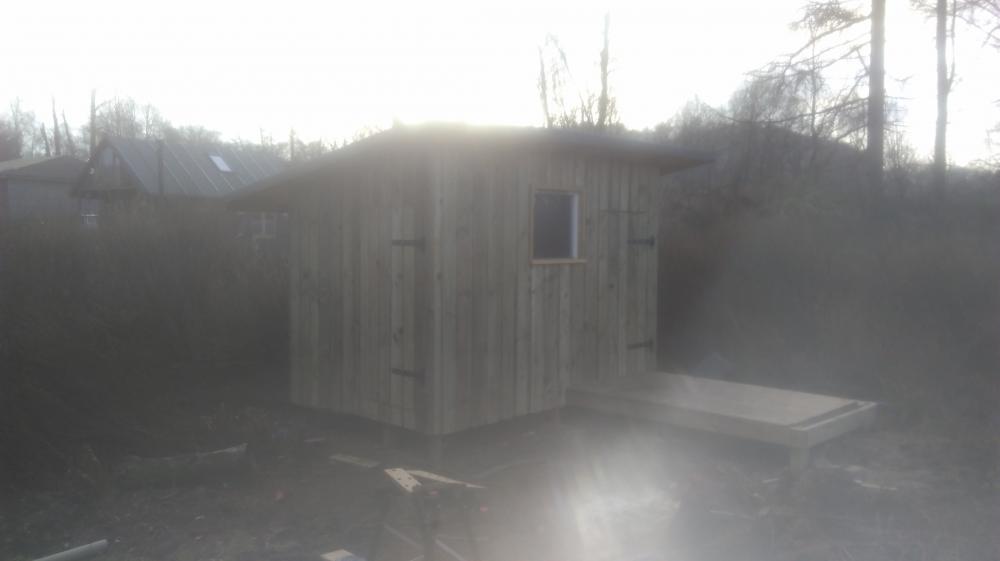Leaderboard
Popular Content
Showing content with the highest reputation on 02/13/17 in all areas
-
Quick about me: Started visiting ebuild.co.uk, fantastic knowledge base, 3rd time lucky got planning permission, did ground works, sold the site (ran out of time, all the kids had fledged the nest) on to local builder who has almost completed the build on a site where the planners just laughed at my vision. Moved to Lochaber and we bought a semi detached Dorran house with no garden, the attributes of the house we were wanting was away up north no neighbours, small house very large garden. We did get the small house and a location. The old saying location, location and location. Still got that itch to build my house. Finally glad to see this site up and running, many thanks for all those who helped me on ebuild.co.uk and those who kept the dream going on this site. John1 point
-
BTW, guys, if you have a maths or physics A level, then I really suggest that you read those two articles that I linked to or I can email you a copy that I reformatted to make it readable in printable layout. I don't want to put this up as a link as this is technically a breech of copyright. @JSHarris, this is all great stuff for me and I need to think / stew about some of the implications, and I am still getting to grips with some of the non-intuitive implications of my design, like I wasn't going to bother with a water softener, until I realised that (after a postcode search from Anglian) that we are at ~275ppm which is way above the recommended maximum for the SunAmps (150 ppm). I really can't see the benefit of putting a softener on the DCW, unless I do Jeremy's trick of wiring in a direct feed to the sink, but I will need one on the DHW side. There are also some pretty non-intuitive things like the impact of adding the PHE in front of the SunAmps. Adding an extra PHE is bound to increase the pressure drop (PD) isn't it? Well no it doesn't, and you can see why here. The PD through the PHE is tiny compared to that through the SunAmps. If the DCW supply is 8°C, to O/P of the SunAmps is 65°C and the PHE output is 18°C and the final mix is 48°C then a high flow, say 25 l/min through two SunAmps is 12½ l/min per SunAmp: The mix without the PHE is 30:70 cold : SA output so the PD of the SunAmp is 0.72 bar The mix without the PHE is 36:64 cold : SA output so the PD of the SunAmp is 0.61 bar The serial impact of the PHE is ~ 0.02 bar so the second has a higher maximum throughput as well as a more efficient use of the SunAmps. But all this exchange is helping me. My original post was more about how we collate all of this for the others who are just following down this same track and need to get up to speed.1 point
-
1 point
-
1 point
-
The Rain in the Lane, Is caused mainly by the Drain? Sorry.....probably low on coffee here...!!1 point
-
We just used them originally to do lots of number-crunching, modelling 3D trajectories. Prior to that, trajectory calculations had been either done by hand (using mechanical "computers") or using analogue computers, that took ages to set up and would tend to drift a fair bit over time. Things progressed at a staggering rate in the 70's and 80's. I remember sitting next to the Tac Nav in a Nimrod MR2 and playing a game with him as to whether the tactical computer could predict the water entry point of a weapon faster than my little Psion3, running a spreadsheet to predict 3D trajectories from the same input data (A/C height, speed, heading, wind speed and direction, plus coriolis correction and the trajectory characteristics of the parachute retarded weapon). The little Psion3 beat the tactical computer hands down, every time, despite me having to manually key in the initial data, taken off the tac nav screen.1 point
-
Just as a practical observation, this is broadly what we have, where I encountered minor problems and how things ended up. - Virtually all the restrictions to flow end up being in the DHW side, rather than the cold side - I ran 25mm MDPE into the house, then 22mm for all the cold feeds as far as the manifold, and all the cold feeds to the water heating, as far as the Sunamp PV. where possible I tried to step up from 15mm to 22mm for any pipe over a metre long on the hot side, but frankly I'm not sure it made a jot of difference given the restriction imposed by the Sunamp PV and the instant water heater. - I ran 15mm plastic from the manifolds to each room with water, with the exception that the utility room and downstairs WC share the same radial feed as they are next to each other. 15mm plastic is more restrictive that 15mm copper, but in practice that seems to be an advantage, as there's less standing pipe loss and the response time of the hot outlets is quicker. - Our incoming pressure is regulated to between 2.5 bar and 3.5 bar, and we can easily flow 25 litres/minute from a 15mm plastic pipe on the cold side, with no restriction, and no significant flow noise in the pipe work. The flow rates originally were such that we were massively non-compliant with the water usage requirements, and were told to fit flow restrictors to all those outlets that didn't have them, then submit a new report showing we were compliant with part G. - I've left the flow restrictors in place on some taps, like all the washbasins and the kitchen and utility room sinks, as they stop excessive splashing and make the taps easier to control - The water softener was a pain to plumb in, because it was delivered with pipes and fittings that were pretty restrictive. I ended up replacing them with bigger bore pipes and fittings, and now the loss through it is pretty small (it's plumbed with the equivalent of 22mm pipe now). - The shower and bath taps were to two items that were pretty poor performers with regs-compliant flow restrictors fitted, so I removed them after completion. Nothing wrong with this as we're not on mains water and so the water usage rules should never have been applied to us in the first place. The shower flow rate was around 11 litres/minute with no restrictors fitted, and, (worth checking!) the hidden flow restrictor washers in the thermostatic shower mixer valve removed. I fitted a 9 litres/minute restrictor to the shower head feed pipe that had no noticeable effect on effectiveness, but failed the test for water usage, so swapped it out for an 8 litres/minute one that did noticeably reduce the effectiveness, just to get a pass. I think I could easily live with the 9 litres/minute restrictor and may re-fit it, really just to give a useful reduction in DHW consumption. - Pipe noise in rooms away from the outlets is non-existent. The plastic pipe itself is, I think, pretty good at suppressing flow noise, and with all the pipes insulated there's no noise at all in the habitable rooms of the house. The only places you can just hear flow noise is the water meter on top of the water softener in the services room and a very gentle sound from the Sunamp PV , but even then it's not audible with the door to that room closed.1 point
-
Domestic science in my opinion should be compulsory for boys and girls. I firmly believe the health of so many is bad due to lack of knowledge about nutrition and how to cook.1 point
-
Sounds good. Just make sure that the lights they specify are going to be generic enough that you'll be able to buy them - or something similar - directly. The brief experience I had involved the specification of a single light (well, a cluster of light types) that would have cost several thousand pounds for a single room, and had no obvious affordable alternative.1 point
-
We put it on with a hessian sack and a pair of rubber gloves, you can push it into any joints that weren't full and you tend not to drop as much as with the brush,but both work very well. Try it both ways. An old fashioned hairy type broom head rather than a synthetic modern broom works better.1 point
-
Amazingly I got a reply over night from the BC officer: So not as onerous as I first though, phew, thanks all1 point
-
1 point
-
I've seen evidence of the leeching effect, As long as the substance actually states its OK then I don't see any issue, but I wouldn't just use any random sealant. I've seen newish T&E in a loft almost completely stripped by polystyrene bead type insulation, In general I stick to using a standard type 'compound' , But if @Onoff reckons its still OK, then I'm sure it is, And I'm sure @ProDave knows of more specific types for better properties at insulation etc most likely. It was just a general warning that not just any old expanding foam/silicon should be used in contact with PVC cables.1 point
-
Or a couple of cheap plastic sweeping brushes and a couple of washing up bowls works just as well1 point
-
Parge coat will be a few mms depth of watery cement sand mix slapped on with a paint brush. No real skill required and it's messy. Scratch coat maybe 10-15mm deep depending on how plumb the wall is and involves a lot of skill to get it right.1 point
-
I wasn't even asked for a pressure test. Posted off my completion form, got my cert back. For all I know they never even visited the site.1 point
-
I thought 2.5 metres only applied if it goes right up to the boundary. If it's 1 metre or more away then the height is 3 metres eaves height. Even my static caravan just squeaks in under that (I left exactly 1 metre between the 'van and the boundary fence)1 point
-
At this point you could stick the remaining payment on a 36 month interest free credit card and pay off gradually until 2020 at almost zero extra cost. At the least the cash could be saved somewhere which would give you an extra 2k or so.1 point
-
Grass was invented by wimmin to keep men out of the way for a few hour every week. I'm with you on this one. How many hours of my life have been wasted by grass? And I'll never get hem back1 point
-
Me too, the utility companies were a complete PITA to deal with, with Openreach being the worst by far, and SSE as our DNO coming a very close second. I think the problem is that if you buy a building plot, your solicitor won't do any of these checks, and neither will the planners when granting PP, so it's entirely down to the buyer to do some research before making an offer to see how much it's likely to cost to get services in. Our case is a reasonable, if, perhaps, extreme, example of how things can be taken for granted and come back and bite you as the plot purchaser. Our plot had been granted planning permission in around 2004, following a prolonged battle with the planners and a few applications. The buyer was a gentleman who wanted to build a house for him and his wife as their retirement house (just like us). The seller was a chap well-known in the village for being a bit on the sharp side when it came to development (he'd bought an old orchard, subdivided it and built some apparently less than well-built bungalows on the top section of it). The chap that bought our plot originally trusted the seller (his first mistake), trusted the plans were accurate (his second mistake) and assumed that because the planning application (on which the permission had been granted) said that mains water and sewerage were available he trusted that too. When the buyer of the plot had completed the purchase, he discovered there was an unmarked big three phase power cable running diagonally across the plot, and only about a foot below the surface. He then discovered that the nearest water main was 140 metres away, and would cost a lot to connect to, and that the nearest main sewer was about 80m away up a steep hill and would also cost a lot to connect to. The combined cost of moving the three phase cable, taking down a power pole, connecting to the water main and connecting to the sewer came to more than he paid for the plot. He simply didn't have the funds to continue, so the plot sat as an untidy and very overgrown mess for the next 7 years, and all he did was renew the planning permission every three years. He put the plot on the market when the planners told him that they would not renew the planning permission in future, and that he would have to re-submit a new application. That's when we came along. We looked at the plot, liked it and I went off to read the planning files online. We didn't want to build the bungalow that had PP, so knew we'd need a new application. I had loads of really good advice on the old Ebuild forum, and that encouraged me to do research on services, very much like this thread. That's when I found out about the cable, the high cost of getting mains water and sewerage and, a bit later, a big boundary error. All told the plot was unsaleable at that stage, so I called the estate agent and said that although we were interested, the plot development cost was way too high and it was misrepresented on his particulars, He asked for copies of the quotes I'd had, plus the topo survey evidence that showed the Land Registry Title Plan was in error and told the seller he couldn't market it as it was. We made a very much lower offer, to take account of the high costs, and eventually (a year after first seeing the plot!) completed the purchase. From what I've read here and on the old Ebuild forum, this sort of thing is far from uncommon, and it's one reason that I'll always try and highlight the issue of doing full and poper checks before you agree to buy a plot.1 point
This leaderboard is set to London/GMT+01:00



.jpg.c21f3ac78c9b7efd90cbdcb312744dc5.thumb.jpg.7adcad4c0e384f5ecd7d56b0618df6e5.jpg)









